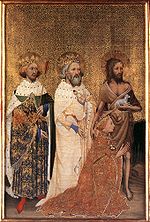- Dowry of Mary
-
Dowry of Mary (or Dowry of the Virgin, Our Lady's Dowry, and similar variations) is a title used in Roman Catholic contexts to refer to England.[1][2][3][4]
Contents
Early use
The title originated in the Medieval period, when devotion to the Virgin Mary in England was particularly strong.[5][6] Mary was seen as a "special protectress" of England, who took personal interest in the country's affairs.[7] Though the title's precise origin is unknown, it had become widespread by the middle of the fourteenth century, and around the year 1350 a mendicant preacher claimed in a sermon that "it is commonly said that the land of England is the Virgin's dowry".[7] Around fifty years later, Archbishop Thomas Arundel, discussing Mary and the Incarnation, wrote that "we English, being ... her own Dowry, as we are commonly called, ought to surpass others in the fervour of our praises and devotions".[8] By the reign of Henry V, England was being referred to in Latin texts as dos Mariae, "dowry of Mary",[9] and according to chronicler Thomas Elmham English priests prayed to "the Virgin, protectress of her dower" on the eve of the Battle of Agincourt.[10]
Depictions in art
The Wilton Diptych, completed around 1395, shows Richard II kneeling before the Virgin and Child. Carried by a nearby angel is the Cross of St George, the staff of which is surmounted by an orb featuring a minuscule map of England.[11] A similar work from the same era, a now-lost altarpiece, showed Richard handing the orb to Mary, with the inscription Dos tua Virgo pia haec est, "This is your dowry, Holy Virgin".[12][13]
In the wake of the English Reformation, the notion of England enjoying a special association or relationship with Mary became an important aspect of recusant Catholic spirituality.[14] The residents at English College owned a painting which depicted Mary being handed a scroll carrying the words "We will remain under the shade of your wings till the wickedness passes" by a group of kneeling Jesuits. The painting's superscription read Anglia dos Mariae, "England, Mary's dowry".[15]
Papal recognition
Pope Leo XIII referred to England's association with the title in 1893. Addressing a group of Catholic pilgrims from England in Rome, he spoke of "the wonderful filial love which burnt within the heart of your forefathers towards the great Mother of God ... to whose service they consecrated themselves with such abundant proofs of devotion, that the kingdom itself acquired the singular and highly honourable title of 'Mary's Dowry.'"[16]
References
- ^ Highley, Christopher (2008), Catholics Writing the Nation in Early Modern Britain and Ireland, Oxford University Press, p. 20. ISBN 978-0199533404
- ^ Womersley, David (2010), Divinity and State, Oxford University Press, p. 16. ISBN 978-0199255641
- ^ Nichols, Vincent et al. Firmly I Believe and Truly: The Spiritual Tradition of Catholic England (2011), Oxford University Press, p. 21. ISBN 978-0199291229
- ^ Cummings, Brian et al. (2010), Cultural Reformations: Medieval and Renaissance in Literary History, Oxford University Press, p. 117. ISBN 978-0199212484
- ^ Bogle, Joanna (1992), A Book of Feasts and Seasons, Gracewing, p. 159. ISBN 978-0852442173
- ^ McNally, Terrence J. (2009), What Every Catholic Should Know About Mary, Xlibris, p. 76. ISBN 978-1441510518
- ^ a b Saul, Nigel (2011), For Honour and Fame: Chivalry in England, 1066-1500, Random House, p. 208. ISBN 978-1847920522.
- ^ Boss, Sarah (2004), Mary, Continuum International Publishing Group, p. 118. ISBN 978-0826457882
- ^ Hilton, Lisa (2009), Queens Consort: England's Medieval Queens, Phoenix Books, ISBN 978-0753826119
- ^ Saul, Nigel (2011), For Honour and Fame: Chivalry in England, 1066-1500, Random House, p. 209. ISBN 978-1847920522.
- ^ Strong, Roy (2000), The Spirit of Britain: A Narrative History of the Arts, Random House, p. 2. ISBN 978-0712664950
- ^ Gordon, Dillian et al. (1998), The Regal Image of Richard II and the Wilton Diptych, Harvey Miller Publishers, p. 24. ISBN 978-1872501727
- ^ Lavezzo, Kathy (2003), Imagining a Medieval English Nation, University of Minnesota Press, p. 177 ISBN 978-0816637348
- ^ Espinosa, Ruben (2011), Masculinity and Marian Efficacy in Shakespeare's England, Ashgate Publishingp. 14. ISBN 978-1409401162
- ^ Shell, Alison (1999), Catholicism, Controversy, and the English Literary Imagination, 1558-1660, Cambridge University Press, p. 206. ISBN 978-0521580908
- ^ Morris, John; Smith, Sydney (1896), Historical Papers, Catholic Truth Society, p. 157.
Categories:- Roman Catholic Mariology
- Marian devotions
- Catholic spirituality
- History of England
- English culture
- Roman Catholic Church in England
- Roman Catholic Church in England and Wales
Wikimedia Foundation. 2010.


